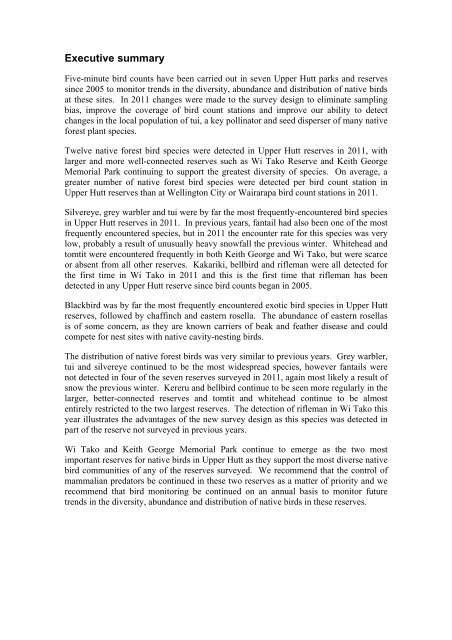State and trends in the diversity, abundance and distribution of birds ...
State and trends in the diversity, abundance and distribution of birds ...
State and trends in the diversity, abundance and distribution of birds ...
You also want an ePaper? Increase the reach of your titles
YUMPU automatically turns print PDFs into web optimized ePapers that Google loves.
Executive summary<br />
Five-m<strong>in</strong>ute bird counts have been carried out <strong>in</strong> seven Upper Hutt parks <strong>and</strong> reserves<br />
s<strong>in</strong>ce 2005 to monitor <strong>trends</strong> <strong>in</strong> <strong>the</strong> <strong>diversity</strong>, <strong>abundance</strong> <strong>and</strong> <strong>distribution</strong> <strong>of</strong> native <strong>birds</strong><br />
at <strong>the</strong>se sites. In 2011 changes were made to <strong>the</strong> survey design to elim<strong>in</strong>ate sampl<strong>in</strong>g<br />
bias, improve <strong>the</strong> coverage <strong>of</strong> bird count stations <strong>and</strong> improve our ability to detect<br />
changes <strong>in</strong> <strong>the</strong> local population <strong>of</strong> tui, a key poll<strong>in</strong>ator <strong>and</strong> seed disperser <strong>of</strong> many native<br />
forest plant species.<br />
Twelve native forest bird species were detected <strong>in</strong> Upper Hutt reserves <strong>in</strong> 2011, with<br />
larger <strong>and</strong> more well-connected reserves such as Wi Tako Reserve <strong>and</strong> Keith George<br />
Memorial Park cont<strong>in</strong>u<strong>in</strong>g to support <strong>the</strong> greatest <strong>diversity</strong> <strong>of</strong> species. On average, a<br />
greater number <strong>of</strong> native forest bird species were detected per bird count station <strong>in</strong><br />
Upper Hutt reserves than at Well<strong>in</strong>gton City or Wairarapa bird count stations <strong>in</strong> 2011.<br />
Silvereye, grey warbler <strong>and</strong> tui were by far <strong>the</strong> most frequently-encountered bird species<br />
<strong>in</strong> Upper Hutt reserves <strong>in</strong> 2011. In previous years, fantail had also been one <strong>of</strong> <strong>the</strong> most<br />
frequently encountered species, but <strong>in</strong> 2011 <strong>the</strong> encounter rate for this species was very<br />
low, probably a result <strong>of</strong> unusually heavy snowfall <strong>the</strong> previous w<strong>in</strong>ter. Whitehead <strong>and</strong><br />
tomtit were encountered frequently <strong>in</strong> both Keith George <strong>and</strong> Wi Tako, but were scarce<br />
or absent from all o<strong>the</strong>r reserves. Kakariki, bellbird <strong>and</strong> rifleman were all detected for<br />
<strong>the</strong> first time <strong>in</strong> Wi Tako <strong>in</strong> 2011 <strong>and</strong> this is <strong>the</strong> first time that rifleman has been<br />
detected <strong>in</strong> any Upper Hutt reserve s<strong>in</strong>ce bird counts began <strong>in</strong> 2005.<br />
Blackbird was by far <strong>the</strong> most frequently encountered exotic bird species <strong>in</strong> Upper Hutt<br />
reserves, followed by chaff<strong>in</strong>ch <strong>and</strong> eastern rosella. The <strong>abundance</strong> <strong>of</strong> eastern rosellas<br />
is <strong>of</strong> some concern, as <strong>the</strong>y are known carriers <strong>of</strong> beak <strong>and</strong> fea<strong>the</strong>r disease <strong>and</strong> could<br />
compete for nest sites with native cavity-nest<strong>in</strong>g <strong>birds</strong>.<br />
The <strong>distribution</strong> <strong>of</strong> native forest <strong>birds</strong> was very similar to previous years. Grey warbler,<br />
tui <strong>and</strong> silvereye cont<strong>in</strong>ued to be <strong>the</strong> most widespread species, however fantails were<br />
not detected <strong>in</strong> four <strong>of</strong> <strong>the</strong> seven reserves surveyed <strong>in</strong> 2011, aga<strong>in</strong> most likely a result <strong>of</strong><br />
snow <strong>the</strong> previous w<strong>in</strong>ter. Kereru <strong>and</strong> bellbird cont<strong>in</strong>ue to be seen more regularly <strong>in</strong> <strong>the</strong><br />
larger, better-connected reserves <strong>and</strong> tomtit <strong>and</strong> whitehead cont<strong>in</strong>ue to be almost<br />
entirely restricted to <strong>the</strong> two largest reserves. The detection <strong>of</strong> rifleman <strong>in</strong> Wi Tako this<br />
year illustrates <strong>the</strong> advantages <strong>of</strong> <strong>the</strong> new survey design as this species was detected <strong>in</strong><br />
part <strong>of</strong> <strong>the</strong> reserve not surveyed <strong>in</strong> previous years.<br />
Wi Tako <strong>and</strong> Keith George Memorial Park cont<strong>in</strong>ue to emerge as <strong>the</strong> two most<br />
important reserves for native <strong>birds</strong> <strong>in</strong> Upper Hutt as <strong>the</strong>y support <strong>the</strong> most diverse native<br />
bird communities <strong>of</strong> any <strong>of</strong> <strong>the</strong> reserves surveyed. We recommend that <strong>the</strong> control <strong>of</strong><br />
mammalian predators be cont<strong>in</strong>ued <strong>in</strong> <strong>the</strong>se two reserves as a matter <strong>of</strong> priority <strong>and</strong> we<br />
recommend that bird monitor<strong>in</strong>g be cont<strong>in</strong>ued on an annual basis to monitor future<br />
<strong>trends</strong> <strong>in</strong> <strong>the</strong> <strong>diversity</strong>, <strong>abundance</strong> <strong>and</strong> <strong>distribution</strong> <strong>of</strong> native <strong>birds</strong> <strong>in</strong> <strong>the</strong>se reserves.
















